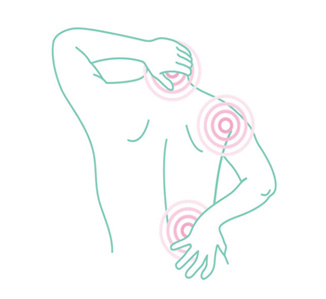
Myofascial Pain Syndrome
Myofascial Pain Syndrome is the chronic disease
caused by the sustained contraction of muscles.
- Muscles of our body are easily contracted by incorrect posture, external
shocks and excessive stress. If this state is sustained for a long time,
muscle fibers become hard like a band and blood circulation becomes
poor, which leads to ischemic state. - When this happens, neurotransmitters which stimulate pain nerve are
secreted and then pain is induced in this area. If the trigger point(tender
point) is pressed, a patient feels severe tenderness. If it is touched by
a hand, he has the feeling of a ball pen lead in the muscle. In addition,
another pain is caused in the distant area by pressing with a hand.
Causes
- Common cause of Myofascial Pain Syndrome is the habituation of wrong posture.
- If you feel stiff in the back even if you don’t strain your back, or if you feel stiff in the shoulder or tight in back of your neck
or you get congested without doing anything, it is mostly caused by Myofascial pain syndrome. - In addition, as people use a computer a lot, patients experiencing Myofascial Pain Syndrome are increasing.
If a person puts both hands on the keyboard and works for a long time, muscles of shoulder are contracted.
If you keep lifting up your head to look at monitor for a long time, muscles of neck are contracted. All of these positions
may cause Myofascial Pain Syndrome.
Treatments & Preventions
-
A doctor can find a trigger point and inject it.
There is the area in which something can be touched in the muscles like rice grain. If it is pressed, a patient feels
severe pain as if he screams out. If the trigger is removed using the injection, the muscle is relaxed so that
the pain is relieved. -
Physical therapy is also helpful.
The goal of physical therapy is to relax the contracted muscles. Electrical stimulation,
ultrasound and hot pack can be applied. -
Massage is also helpful.
If muscles of both sides and back of neck and shoulders are massaged, everyone feels pains and refreshing.
The reason is that a person feels pains as tender point in contracted muscles is pressed but he feels refreshing as
contracted muscles are relaxed with hand massage.
The place where you feel the most painful and touch it like grains by pressing it with your own hand is firmly
pressed with a thumb for 10-20 seconds to feel the pain. It is repeated at least 10 times.
It would be helpful to muscles of back, if a tennis ball is placed on the place where you feel the pain
while you lie down, and it is gently pressed in the same way.
Stretching for Myofascial Pain Syndrome
- Tender points caused by Myofascial Pain Syndrome are formed mostly in muscles along the spine behind neck,
shoulder muscles, scapula in upper back and trapezius muscle stretching to shoulder. - If you perform following stretching for 10 seconds/ one session for a total of 10 times and it is performed at least
three times a day, it will help you a lot.
-

01
If you have pains on muscle behind neck and shoulder
muscles, you can hold the head in the opposite side
and stretch the appropriate muscle by pulling it in
45° in opposite direction to pain. -
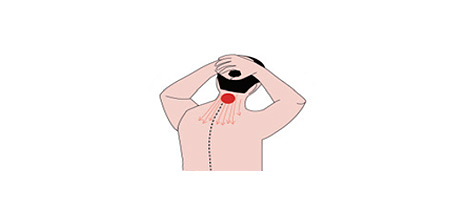
02
If you have pains only on muscles behind the neck,
you clasp both hands and hold the head, and then
you pull it as hard as possible as if you bow. -
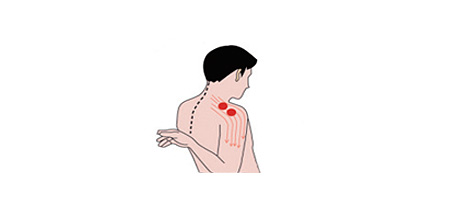
03
If you have trigger point below the shoulder,
you can put the arm behind back and pull it to stretch
the appropriate muscles. -

04
If you have trigger point on side muscles in upper
part of back, you can put the arm behind back and
straighten the arm to stretch the appropriate muscles
on place where you feel the pain. -
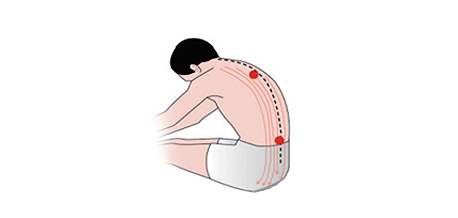
05
If you feel pain on muscles in the central part of upper
back, you take the posture to make the back round.
If you feel pain in left or right part of back, it is good to
twist the upper part in opposite direction to pain.
The posture to make muscles in central part of lower
part of back is the same, but the center of stretching is
focused on the bottom. In addition, you can twist the
waist slightly depending on left and right positions. -
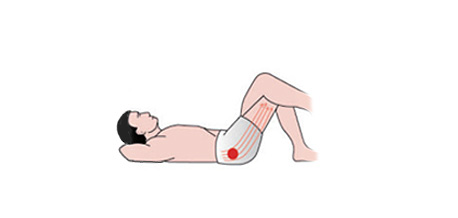
06
Pain of muscles of upper part of hip can be relieved
by crossing your legs and pulling it in opposite
direction to pain as hard as possible while
lying down.

